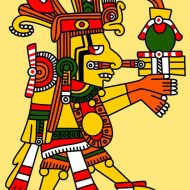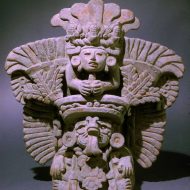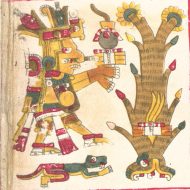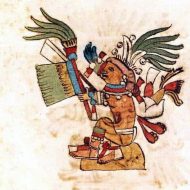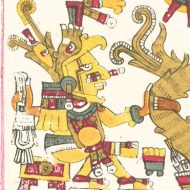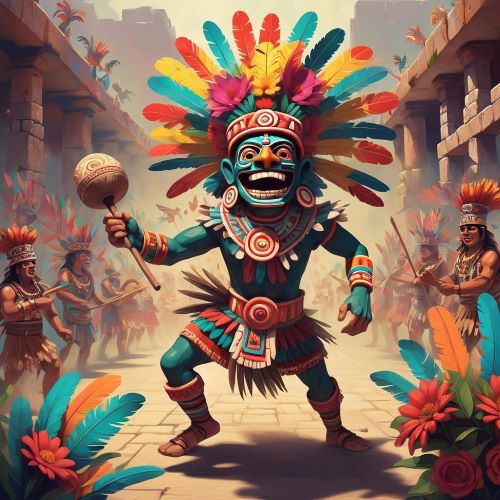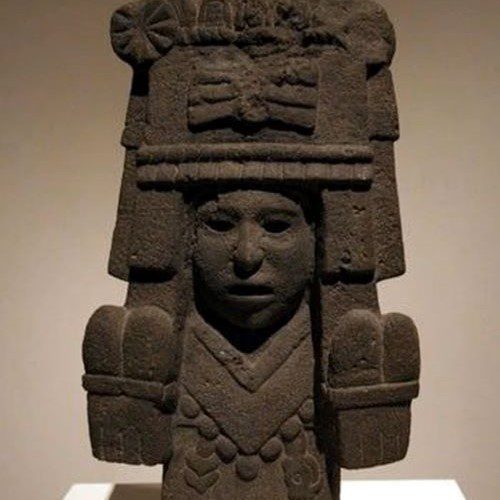Cinteotl : God of Maize
Listen
At a glance
| Description | |
|---|---|
| Origin | Aztec Mythology |
| Classification | Gods |
| Family Members | Tlazolteotl (Mother), Piltzintecuhtli (Father), Chicomecoatl (Wife) |
| Region | Mexico |
| Associated With | Corn, Maize, Harvest |
Cinteotl
Introduction
Cinteotl, known as the Corn God, is closely tied to maize, a fundamental crop in Mesoamerican cultures, and holds profound importance within Aztec mythology. In the pantheon of Aztec deities, Cinteotl stands as a potent symbol representing fertility, agriculture, and sustenance. His significance transcends the confines of ancient temples, leaving a lasting imprint on both cultural and agricultural practices in the contemporary world. Cinteotl, the Maize God, was not merely a deity; he embodied the life force of the Aztec civilization, symbolizing sustenance, fertility, and the intricate equilibrium between humanity and nature. Maize, or corn, was the cornerstone of the Aztec diet, woven into their daily lives, rituals, and even their creation myths. Centeotl wasn’t just a provider; he was a teacher, showcasing the intricate connection between humans and the natural world
Physical Traits
Despite the pivotal role he plays, Centeotl’s physical representation exhibits variations across different sources. In Aztec codices, he is frequently depicted as a youthful figure with an almost effeminate countenance. His body is adorned with yellow paint, symbolizing the radiant hue of ripe corn. Sprouts and maize ears emerge from his head, serving as tangible manifestations of his divine connection to the grain. Alternatively, some interpretations present Centeotl as a more robust figure, wielding a staff embellished with maize cobs. Certain depictions even associate him with Oçomàtli, the playful Monkey God, emphasizing the joyful and celebratory aspects of harvest and abundance.
Cinteotl is commonly portrayed as a young man with a distinctive yellow body coloration. One striking trait is the black line that runs down his eyebrow, traverses his cheek, and concludes at the bottom of his jawline. Depictions of Cinteotl consistently feature maize incorporated into his headdress, underscoring his integral association with this staple crop.
Family
As per the Florentine Codex, Cinteotl is stated to be the offspring of the earth goddess Tlazolteotl and the solar deity Piltzintecuhtli, linked to the planet Mercury. Alternatively, another myth proposes that he is the son of the goddess Xochiquetzal. Centeotl’s family lineage illustrates the intricate connections within the Aztec pantheon. In one narrative, he is portrayed as the progeny of Tlazolteotl, the earth goddess, and Piltzintecuhtli, the fire god, emphasizing the crucial roles of both earth and fire in nurturing maize. Other legends identify him as the son of Xochiquetzal, the goddess of flowers and beauty, further highlighting the inseparable link between maize and the vibrant mosaic of life.
Additionally, Centeotl shares a close association with Chicomecoatl, the goddess known as the “Seven Serpent,” symbolizing seed corn and the promise of future harvests. Their union symbolically represents the cyclical nature of agriculture, depicting the continual cycle of death and rebirth of maize that ensures the survival and prosperity of the Aztec people.
Other names
Cinteotl, also known as Centeocihuatl or Centeotl, possesses a name rich in symbolic meaning, where “Cintli” denotes “dried maize still on the cob,” and “teōtl” translates to “deity.” This multifaceted deity isn’t confined to a singular name, showcasing the diversity within his nature. Among his alternative names are Xochipilli, the “Flower Prince,” emphasizing his connection with joy, fertility, and the beauty found in the abundance of nature. Additionally, Uexotzin, meaning “Young Maize,” highlights Centeotl’s role as the protector of emerging crops and the promise inherent in future harvests. Lastly, Cinteotl Ixtli, the “Black Maize God,” represents the deity’s darker and more mysterious aspects, intricately associated with themes of death and rebirth.
Powers and Abilities
As the deity overseeing maize and agriculture, Cinteotl played a crucial role in the cultivation of maize and other essential crops in Mesoamerica. Revered as the primary source of fertility and abundance, Cinteotl embodied the interconnected forces of nature and humanity within Mesoamerican cosmology. His powers, reflective of his diverse names, extended across various domains.
Centeotl held the ability to influence weather conditions, ensuring timely rain for parched crops and ample sunshine for the ripening of ears. Additionally, he possessed the capacity to shape the growth and fertility of maize, guaranteeing abundant harvests while safeguarding crops from pests and diseases. Beyond the physical realm, myths attributed to Cinteotl suggested that he possessed the power to heal the sick and even resurrect the dead, illustrating the deity’s profound influence on both agricultural and human well-being.
Modern Day Influence
The impact of Cinteotl transcends the confines of Aztec culture, tracing its roots back to the Olmecs and Mayans. The veneration of Cinteotl was deeply ingrained in the cultural practices of these civilizations, involving festivals, ceremonies, and sacrifices aimed at securing abundant harvests. Beyond the ancient rituals, Cinteotl’s influence persists in the present day, serving as a muse for artists, writers, and scholars alike.
In contemporary times, the image of Centeotl finds expression in various forms, from murals and sculptures to even making appearances in video games. These modern representations underscore the enduring power and relevance of this ancient deity, as his presence continues to inspire creativity and reflection across different artistic mediums. Cinteotl’s cultural legacy serves as a bridge connecting the past with the present, fostering an ongoing appreciation for the rich tapestry of Mesoamerican mythology.
Related Images
Frequently Asked Questions
What is lorem Ipsum?
I am text block. Click edit button to change this text. Lorem ipsum dolor sit amet, consectetur adipiscing elit. Ut elit tellus, luctus nec ullamcorper mattis, pulvinar dapibus leo.
What is lorem Ipsum?
I am text block. Click edit button to change this text. Lorem ipsum dolor sit amet, consectetur adipiscing elit. Ut elit tellus, luctus nec ullamcorper mattis, pulvinar dapibus leo.
What is lorem Ipsum?
I am text block. Click edit button to change this text. Lorem ipsum dolor sit amet, consectetur adipiscing elit. Ut elit tellus, luctus nec ullamcorper mattis, pulvinar dapibus leo.
What is lorem Ipsum?
I am text block. Click edit button to change this text. Lorem ipsum dolor sit amet, consectetur adipiscing elit. Ut elit tellus, luctus nec ullamcorper mattis, pulvinar dapibus leo.
What is lorem Ipsum?
I am text block. Click edit button to change this text. Lorem ipsum dolor sit amet, consectetur adipiscing elit. Ut elit tellus, luctus nec ullamcorper mattis, pulvinar dapibus leo.

